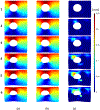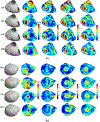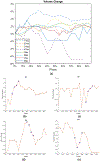Quantifying irregular pulsation of intracranial aneurysms using 4D-CTA
- PMID: 39128410
- PMCID: PMC12208680
- DOI: 10.1016/j.jbiomech.2024.112269
Quantifying irregular pulsation of intracranial aneurysms using 4D-CTA
Abstract
Recent studies have suggested that irregular pulsation of intracranial aneurysm during the cardiac cycle may be potentially associated with aneurysm rupture risk. However, there is a lack of quantification method for irregular pulsations. This study aims to quantify irregular pulsations by the displacement and strain distribution of the intracranial aneurysm surface during the cardiac cycle using four-dimensional CT angiographic image data. Four-dimensional CT angiography was performed in 8 patients. The image data of a cardiac cycle was divided into approximately 20 phases, and irregular pulsations were detected in four intracranial aneurysms by visual observation, and then the displacement and strain of the intracranial aneurysm was quantified using coherent point drift and finite element method. The displacement and strain were compared between aneurysms with irregular and normal pulsations in two different ways (total and stepwise). The stepwise first principal strain was significantly higher in aneurysms with irregular than normal pulsations (0.20±0.01 vs 0.16±0.02, p=0.033). It was found that the irregular pulsations in intracranial aneurysms usually occur during the consecutive ascending or descending phase of volume changes during the cardiac cycle. In addition, no statistically significant difference was found in the aneurysm volume changes over the cardiac cycle between the two groups. Our method can successfully quantify the displacement and strain changes in the intracranial aneurysm during the cardiac cycle, which may be proven to be a useful tool to quantify intracranial aneurysm deformability and aid in aneurysm rupture risk assessment.
Keywords: 4D-CTA; Intracranial aneurysm; Irregular pulsation; Strain.
Copyright © 2024 The Authors. Published by Elsevier Ltd.. All rights reserved.
Conflict of interest statement
Declaration of competing interest The authors declare that they have no known competing financial interests or personal relationships that could have appeared to influence the work reported in this paper.
Figures







Similar articles
-
Irregular pulsation on 4D-CTA and quantitative wall enhancement on VW-MRI are associated with symptoms of unruptured intracranial aneurysms.J Neurointerv Surg. 2025 Jan 27:jnis-2024-022483. doi: 10.1136/jnis-2024-022483. Online ahead of print. J Neurointerv Surg. 2025. PMID: 39622639 Free PMC article.
-
Sertindole for schizophrenia.Cochrane Database Syst Rev. 2005 Jul 20;2005(3):CD001715. doi: 10.1002/14651858.CD001715.pub2. Cochrane Database Syst Rev. 2005. PMID: 16034864 Free PMC article.
-
The association between lunar phase and intracranial aneurysm rupture: Myth or reality? Own data and systematic review.BMC Neurol. 2017 May 19;17(1):99. doi: 10.1186/s12883-017-0879-1. BMC Neurol. 2017. PMID: 28525979 Free PMC article.
-
Intravenous magnesium sulphate and sotalol for prevention of atrial fibrillation after coronary artery bypass surgery: a systematic review and economic evaluation.Health Technol Assess. 2008 Jun;12(28):iii-iv, ix-95. doi: 10.3310/hta12280. Health Technol Assess. 2008. PMID: 18547499
-
Endovascular treatment for ruptured abdominal aortic aneurysm.Cochrane Database Syst Rev. 2017 May 26;5(5):CD005261. doi: 10.1002/14651858.CD005261.pub4. Cochrane Database Syst Rev. 2017. PMID: 28548204 Free PMC article.
References
-
- Can A, Du R, 2016. Association of hemodynamic factors with intracranial aneurysm formation and rupture: systematic review and meta-analysis. Neurosurgery 78, 510–520. - PubMed
-
- D’Urso PI, Lanzino G, Cloft HJ, Kallmes DF, 2011. Flow diversion for intracranial aneurysms: a review. Stroke 42, 2363–2368. - PubMed
-
- Ferrari F, Cirillo L, Calbucci F, Bartiromo F, Ambrosetto P, Fioravanti A, Leonardi M, 2016. Wall motion at 4D-CT angiography and surgical correlation in unruptured intracranial aneurysms: a pilot study. J. Neurosurg. Sci. 63, 501–508. - PubMed
MeSH terms
Grants and funding
LinkOut - more resources
Full Text Sources
Medical

